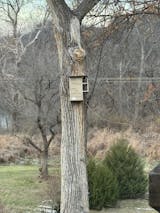If you’ve ever heard a rhythmic tapping in your backyard and looked up to see a bird with a splash of yellow on its belly and a red cap, you may have just met the Yellow-Bellied Sapsucker—a name that sounds like an old-timey insult but is actually one of North America’s most fascinating woodpeckers.
In this blog, we’ll dive into everything you need to know about this quirky bird—from its diet and nesting habits to fun facts and how to attract it to your yard. Whether you're a seasoned birder or just starting to explore backyard wildlife, the Yellow-Bellied Sapsucker is a species worth knowing.
1. Who Is the Yellow-Bellied Sapsucker?
The Yellow-Bellied Sapsucker (Sphyrapicus varius) is a medium-sized woodpecker native to North America. It’s known for its distinctive behavior of drilling neat rows of holes in trees to feed on sap and insects. Males sport a red forehead and throat, while females have a red forehead but a white throat. Both sexes have a pale yellow belly—hence the name!

2. Range and Migration
These birds are migratory, breeding in Canada and the northeastern United States, and wintering in the southeastern U.S., Mexico, Central America, and the Caribbean. If you live in Southern Indiana (like us here at JCS Wildlife), you’re likely to spot them during their migration or winter stay.
They prefer deciduous forests, especially those with birch, maple, and hickory trees—prime sap sources!

3. Diet: More Than Just Sap!
Despite their name, Yellow-Bellied Sapsuckers don’t live on sap alone. Their diet includes:
- Tree sap (from their signature sap wells)
- Insects attracted to the sap
- Ants, beetles, and spiders
- Fruit and berries (especially in winter)
To attract them to your yard, consider offering suet feeders, mealworms, or fruit blends. Our JCS Wildlife Suet Feeders are perfect for this!

4. Nesting Habits
Yellow-Bellied Sapsuckers are cavity nesters. They excavate holes in dead or decaying trees, usually high up and away from predators. The female lays 4–6 white eggs, and both parents share incubation duties.
Fun fact: They often reuse the same nesting tree year after year, though they’ll carve out a fresh cavity each season.

5. Tree Tapping: Nature’s Syrup Harvesters
One of the most unique behaviors of this bird is its sap well drilling. They create horizontal rows of holes in trees to access the sap. These wells also attract insects, which the sapsucker gleefully gobbles up.
While this behavior is fascinating, it can sometimes harm trees. But don’t worry—most healthy trees recover just fine.

6. How to Attract Yellow-Bellied Sapsuckers to Your Yard
Want to host these feathered sap-lovers in your backyard? Here’s how:
- Offer suet and fruit feeders: They love high-energy foods, especially in winter.
- Plant native trees: Birch, maple, and hickory are favorites.
- Leave dead trees standing (if safe): These provide nesting sites.
- Provide fresh water: A heated birdbath in winter can be a magnet.
Check out our full range of bird feeders and houses to get started!

7. Fun Facts About the Yellow-Bellied Sapsucker
- 🐦 They’re the only woodpecker in eastern North America that’s truly migratory.
- 🌳 Their sap wells are used by other species, including hummingbirds!
- 🎶 Their drumming is slower and more irregular than other woodpeckers.
- 🧭 They navigate thousands of miles during migration with pinpoint accuracy.
- 🥚 Both parents incubate the eggs and feed the chicks.
- 🧠 They remember and revisit productive sap trees year after year.
- 🐜 They eat more insects than sap during breeding season.
- 🎨 Juveniles lack the red markings and have a more mottled appearance.
- 🕳️ They can excavate a nest cavity in just a few days.
- 🐝 They sometimes get stung by bees while feeding on sap!
8. Yellow-Bellied Sapsucker vs. Other Woodpeckers
| Species | Key Traits | Feeding Behavior | Range |
|---|---|---|---|
| Yellow-Bellied Sapsucker | Red forehead, yellow belly | Sap wells + insects | Migratory across North America |
| Downy Woodpecker | Small, white belly, black wings | Insects, suet | Year-round in most of U.S. |
| Hairy Woodpecker | Larger than Downy, longer bill | Insects, bark foraging | Similar to Downy |
| Red-Bellied Woodpecker | Red cap, faint red belly | Nuts, fruit, insects | Eastern U.S. |
| Pileated Woodpecker | Large, red crest | Carpenter ants, insects | Forested areas across U.S. |
9. Conservation Status
Good news! The Yellow-Bellied Sapsucker is listed as Least Concern by the IUCN. Their populations are stable, though habitat loss and tree removal can impact nesting sites.
You can help by maintaining bird-friendly yards, planting native trees, and supporting conservation efforts.

10. Final Thoughts: Why We Love the Yellow-Bellied Sapsucker
At JCS Wildlife, we’re all about celebrating the quirky, colorful characters that visit our backyards—and the Yellow-Bellied Sapsucker is no exception. With its rhythmic tapping, sap-sipping habits, and vibrant plumage, it’s a bird that brings both charm and ecological value to your outdoor space.

Whether you're looking to attract sapsuckers or other songbirds, we’ve got everything you need—from feeders and houses to high-quality bird food. Explore our collection and turn your backyard into a haven for wildlife!
Ready to welcome the Yellow-Bellied Sapsucker to your yard?
Browse our birding essentials and start your backyard adventure today!




